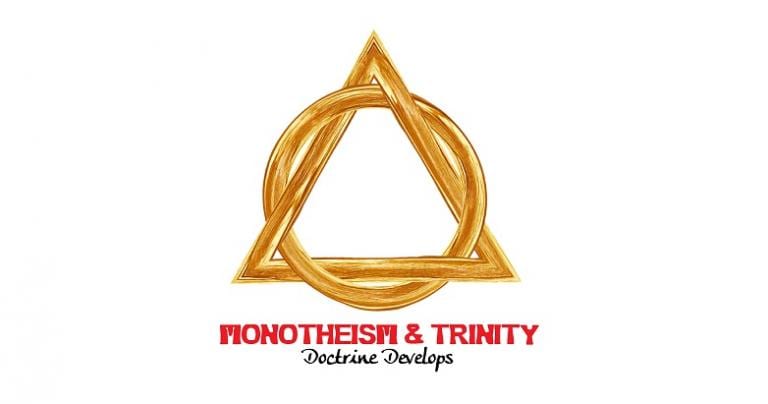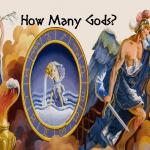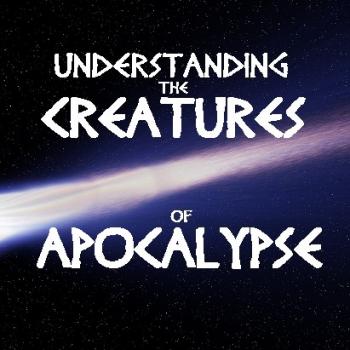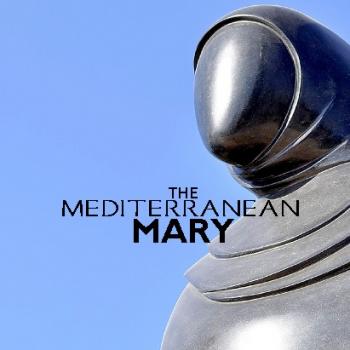
Monotheism and the doctrine of the Trinity evolved through an amazing process in many messy social structures.
Monotheism! How did our ancestors in the faith ever arrive at that? In our last post, we saw that most (if not all) of the Bible understands and presents God in a henotheistic way. We learned that unlike later monotheism, henotheism is one-god-ism. A henotheist accepts that there exist many, many gods. But henotheism sanctions worship of these other deities in favor of only one.
Also in our last post, we learned why the Bible is henotheistic. It was because of the cognitive principle of analogy championed by St. Thomas Aquinas and recently improved by the social sciences. You should read this previous post first before tackling this one.
But how did we ever arrive at monotheism, an essential for our Christianity? First, watch the video here—
Persian Influence on the Bible
Throughout most of the history of biblical Israel there was no suitable social structure to serve as an analogue for monotheism. Perhaps this changed with the Persian Empire.
It’s difficult to exaggerate the importance Persian influence had on Israelite culture and custom. Without Persian-trained, Persian-authorized scribes, there would be no Exodus story (modeled after the immigration experience from Persia). So too there would be no Pentateuch without Persia. Angels were originally a Persian concept. So too were the Devil and the satan (at first and for a long while, two different ideas).
So many biblical ideas are Persian concepts. Paradise comes from a Persian word meaning an enclosed garden fit for royalty. In the land of Persia they speak Farsi, which sounds an awful lot like Pharisee, no? Persia shaped the way Israelites understood resurrection for the righteous and a beyond-life after death. These aren’t coincidences. Many Persian originals shaped the world leading up to our New Testament.
Monotheism: A Persian Export?
Maybe one of these Persian cultural exports was monotheism. An early monotheism comes from Persia—the land of Zoroaster. But how did they manage to develop that? Since all theology is analogy based in culturally-specific human experience, we have to look at what was peculiar to social structures in the Persian Empire. Could it be that the Persian ruler, truly a king of kings, proved to be a fitting analogue for a God ruling over all other gods?
According to Context Scholars Bruce Malina and Richard Rohrbaugh, it was through the Persian monarchy dominating the whole world that the Middle East first encountered monotheism. Whether we consider monotheism as an abstract philosophical system or as a practical political-religious operation, you need a one-world empire to begin it. Malina and Rohrbaugh explain that just like Zoroaster, Israelite prophets also, through their Persian experience, were aided at seeing the oneness and uniqueness of God. This may explain what is perhaps the first taste of biblical monotheism in the songs of Deutero-Isaiah (Isaiah 40—55), if indeed monotheism is there at all!
Short-lived Experience
But the oasis for Persian-influenced monotheism lasted only briefly. Alexander of Macedon conquered the Persians, and quickly, his own empire disintegrated. What remained was yet another “henotheistic” arrangement of many competing kings. Consequently, henotheism reigned in Israel all the way through New Testament times. This was because Israel lacked a social structure as apt analogy for monotheism to flourish.
Imperial Rome: A New Analogy for Monotheism
But things again changed with Rome. Malina and Rohrbaugh explain that the Roman Empire gave the circum-Mediterranean a total social structure touching every land and people. At its head, enthroned, a single emperor dominated everyone and everything. Monotheism now had a sufficient undergirding analogy. And unlike Alexander’s rule, this new empire was no brief candle.
Jesus and Henotheism
People composed and edited the New Testament documents in Roman imperial times. So what do we have then in the New Testament, monotheism or henotheism? According to Malina and Rohrbaugh, henotheism still reigned. In the late 20s CE, in the Galilee, the Jesus Movement was henotheistic, concerned with the God of Israel establishing theocracy in the land of Israel for Israelites. This reflects henotheism.
Paul and Henotheism
Still no monotheism is to be found in Paul and his second wave Jesus groups. Paul’s innovation was the Gospel of the God of Israel. Paul said the God of Israel raised the Israelite messiah Jesus from death to establish an immanent Israelite theocracy.
Contrary to widespread popular belief, Paul didn’t care about non-Israelites. He tolerated them. Indeed, in the only place he addresses them in his seven authentic letters, Paul roundly insults Gentiles (Romans 11:13-24). This reflects henotheism.
The First Gospels and Henotheism
By the time we hit the third wave Jesus groups of “Mark” and “Matthew,” henotheism is still going strong. Read in context, third-waver “Matthew” has his risen Jesus issuing a final edict to make disciples of all Israelites living among all peoples (Matthew 28:16-20). Our English translations, glued to theological commitments, botch this. The Matthean Jesus is not saying “make disciples of all nations” or calling for proselytizing Gentiles—that’s not what the Greek says.
Read very carefully Matthew 10:5-6 and 15:24. The Matthean Jesus has no use for non-Israelites.
“Luke-Acts” and Henotheism
By the fourth wave, things do begin to open up slightly (Luke 10:29-37; 17:11-19). Nevertheless, the author we call “Luke” concludes his Gospel in similar henotheistic fashion to “Matthew.” According to the Lukan Jesus, repentance and the forgiveness of sin against Israel’s patron God is for Israelites in covenant (Luke 24:44-49). Contrary to widespread popular misunderstandings, in the Gospel of “Luke” repentance and forgiveness of sins is for Israelites only.
Then in “Acts,” the author called “Luke” reports how Israelite emigres dwelling throughout the Mediterranean became disciples. Shockingly, we read also in “Acts” how God calls non-Israelites into the Jesus groups (Acts 13:46-52). This offense shocked and confounded Israelites, by the way. So even as we exit New Testament times, henotheism remained strong and thus monotheism was not established in the Jesus groups.
What Changed Things?
So how did monotheism take over? According to Malina and Rohrbaugh, initially Jesus groups diffused throughout the Roman Empire. Believers proclaimed Jesus Christ as the unique broker or mediator between God and man. Within the Roman imperial structure, the God of Jesus was proclaimed as being one (1 Timothy 2:5). Hence, in this matrix, monotheism began evolving into the Jesus traditions.
According to Malina and Rohrbaugh, with Emperor Constantine in the early fourth century, monotheism had been established in Christianity. These scholars suggest that monotheism was perhaps “the radical way” Christianity differed from its sister born also of henotheistic Israelite Yahwism, the newly born Jewish kinship religion. Things complicate afterwards, and Islam played a heavy influence on shaping later, more severe, monotheistic traditions.
Let’s Talk Trinitarian Monotheism
And what of Trinitarian monotheism, the mystery of three persons in one God? We just passed Trinity Sunday, after all! Before we could reach our contemporary Christian understanding of the Trinity, great turmoil and struggle took place. A millennium of theological reflection and bitter debates happened. In 235 CE, Nicaea surely cultivated the understanding of three distinct persons in one God, but this wasn’t dogma until the Fourth Lateran Council, 1215 CE.
The supreme Mystery of Trinity, standing with the Incarnation at the absolute center of Christianity, has roots in Scripture. But theological work—and the doctrine and dogma produced by it—is poorly compared to ready-made items at a convenience store. We need a sense of both culture and history to see this.
Without the terrible disputes lasting a thousand years in the East and West, without exiles and tortures, where would our understanding of Trinity be? And without the Benedictine monasteries of the ninth and eleventh centuries, where would it be? And if Pope John XXII hadn’t decreed in 1334 that the entire Church should observe the Divine Office of the Blessed Trinity, where would it be?
You Can’t Box God!
Here are some takeaways to all of this. Doctrine develops. And that’s okay! God is with us through the evolution and messiness. And the Real God is more than we can make of God, or think about God, or say about God, always. The Real is always more. Our words are good—but none of our words and God-talk, no matter how solemnly proclaimed or enshrined, can ever box up God or definitively explain God. No one, no age, and no culture, no theologian or mystic, owns the patent on articulating God and Christ. We are forever unpacking the Mystery that has been revealed.
And this helps show why so much popular Catholic authorship, apologetics, media, and personalities are wrong-headed and spiritually bankrupt. Don’t proof-text the Bible, folks. Despite Scott Hahn, Catholic Answers, and a host of others, don’t turn it into a connect-the-dots for Bible Wars that “prove” our Catholic tradition.
That’s missing the mark, fellow dying inmates.












